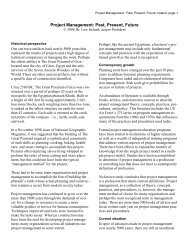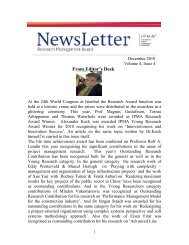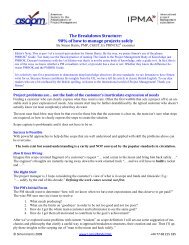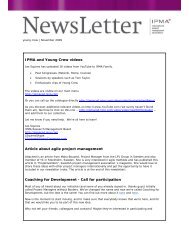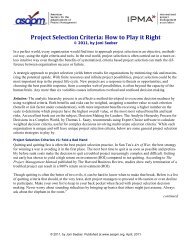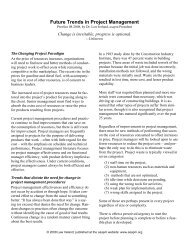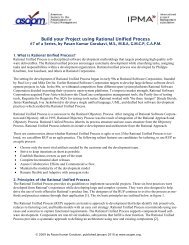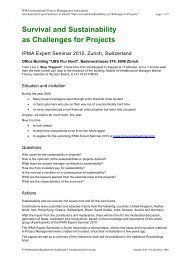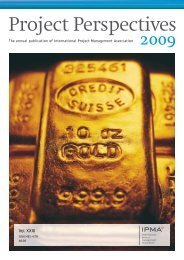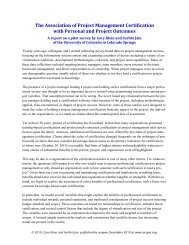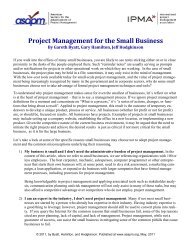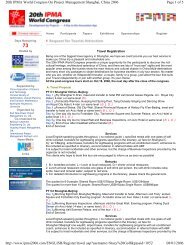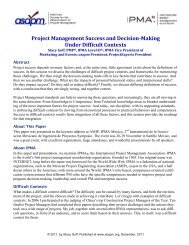Program & Project Manager Power – What are your most ... - asapm
Program & Project Manager Power – What are your most ... - asapm
Program & Project Manager Power – What are your most ... - asapm
Create successful ePaper yourself
Turn your PDF publications into a flip-book with our unique Google optimized e-Paper software.
<strong>Program</strong> & <strong>Project</strong> <strong>Manager</strong> <strong>Power</strong> <strong>–</strong><br />
<strong>What</strong> <strong>are</strong> <strong>your</strong> <strong>most</strong> important traits to achieve success?<br />
By Jeff Hodgkinson, Gary Hamilton and G<strong>are</strong>th Byatt<br />
“Happiness is the full use of <strong>your</strong> powers along lines of excellence in a life affording scope…"<br />
John Fitzgerald Kennedy, 35th President of the United States<br />
An Analogy…<br />
Years ago as kids, when we all didn’t know (or worry about) what project management was, our "Bodies of Knowledge"<br />
were comic books (we acknowledge that many adults read such material today). We couldn’t wait for the next monthly<br />
or weekly issue to come out of Superman or X-Men, or the Fantastic Four, or Spiderman to name just a few. Of course,<br />
not all comic books involved superheroes, but many of them did. Each superhero in our imaginary worlds has at least<br />
one or more special skills or powers that made them champions for justice and “the greater good”. Let’s not forget the<br />
arch nemesis and villains like Lex Luthor, Magneto, or Dr. Doom that had similar powers but used them for the wrong<br />
intent.<br />
Today we probably all know some of our colleagues as ‘superheroes’ for the efforts they give or the results they achieve<br />
individually and/or with their team. Are they considered our champions or Olympians in program and project management?<br />
Do you admire them for their strength the same way one might respect a person who can undertake admirable<br />
feats of physical endurance or run at incredible speeds?<br />
If so, then let’s assume that you <strong>are</strong> somewhere along the continuum of being weak or a very fit strongperson with <strong>your</strong><br />
‘<strong>Program</strong> and/or <strong>Project</strong> Management powers’. As you should know, there <strong>are</strong> several kinds of ‘power’ in management<br />
such as real, formal, position, implied, reverent, proxy (acting), informal, expert, to name a few. <strong>What</strong> ‘powers’ does a<br />
<strong>Program</strong> or <strong>Project</strong> <strong>Manager</strong> need to have, and how can they use them to their advantage?<br />
Our Observations and Suggestions…<br />
<strong>Program</strong> and <strong>Project</strong> <strong>Manager</strong>s work in all types of organizations and undertake all sorts of initiatives across a broad<br />
spectrum of functional disciplines. Some <strong>Program</strong>/<strong>Project</strong> <strong>Manager</strong>s may be organizational atop the hierarchy while others<br />
<strong>are</strong> ”lower down the chain”. <strong>What</strong> truly distinguishes some as leaders in their program/project role, where team<br />
members eagerly look forward to working on the initiatives they lead?<br />
In project and program management, just as in other professions, a great leader needs to have a mix of attributes. Take a<br />
moment to answer the question, “Who do I consider a great leader?” A few famous names may come to mind, such as<br />
military leaders (maybe Admiral Nelson of the British Navy), Heads of State (Abraham Lincoln, or Winston Churchill<br />
perhaps), famous sports captains (Bobby Moore of England’s 1960s World Cup winning side, or the famous Pakistani<br />
cricketer Imran Kham) and/or Visionary business persons (such as Henry Ford, Richard Branson, or Enzo Ferrari).<br />
There is a fair chance that the people you thought of possess ‘real power’. They may well have been the appointed or<br />
elected leaders for their entity or organization (maybe they were founders), with ‘formal power’, yet not all such men<br />
and women in these positions <strong>are</strong> considered true leaders. For example, Richard Nixon and Abraham Lincoln were both<br />
elected President of the United States of America and clearly had the formal power this position carries. However, history<br />
and general opinion often regards them very differently in the aspect of being great leaders. So even when formal<br />
power is bestowed, what makes some stand out as true leaders whereas others do not?<br />
Role models <strong>are</strong> those that we look up to, and aspire to be like. These people <strong>are</strong> true leaders that demonstrate an emotional<br />
intelligence that picks up the needs of others, and a “persona” that others look up to.<br />
© 2010, Jeff Hodgkinson, Gary Hamilton and G<strong>are</strong>th Byatt; published by <strong>asapm</strong>, May, 2010 at www.<strong>asapm</strong>.org.
<strong>Program</strong> & <strong>Project</strong> <strong>Manager</strong> <strong>Power</strong>, by Hodgkinson, Hamilton and Byatt; page 2<br />
People that <strong>are</strong> genuine role models with ‘real power’ have the expertise to ‘walk the talk’ and <strong>are</strong><strong>–</strong>crucially<br />
<strong>–</strong> people that others enjoy working with and for, often because they feel they can learn from them the <strong>most</strong> or<br />
they have the best chance of success and the rewards that can possibly be bestowed as a result of the success.<br />
Formal power (if you have it) is advantageous, but it does not mean people respect you and want to work for<br />
and with you. A <strong>Program</strong> / <strong>Project</strong> <strong>Manager</strong> may be given formal power to lead their team, however, the nature<br />
of their role leads more often than not to them having to rely more on ‘referent’ or ‘expert power’. A<br />
<strong>Program</strong> / <strong>Project</strong> <strong>Manager</strong>’s power is primarily derived from the expertise and experience they possess in<br />
managing their work and/or the process or product contained within the chartered initiative. It is interesting<br />
to note that, in general, when evaluating projects and programs in Retrospectives, such lesson learned often<br />
reveal that the expertise of the <strong>Project</strong>/<strong>Program</strong> manager is not the only indicator of their qualities to effectively<br />
lead a team and achieve a successful outcome.<br />
Examples of Differences…<br />
Example #1: The <strong>Program</strong> <strong>Manager</strong> who has referent power but lacks leadership qualities <strong>–</strong> not good! Referent<br />
power can get them so far, but not “all the way” to getting things across the line. A lack of true leadership<br />
qualities can be resolved through coaching, as long as the person is willing to practice and learn what<br />
leadership is. It is the responsibility of the organization to make sure that people in <strong>Program</strong> <strong>Manager</strong> roles<br />
have leadership qualities.<br />
Example #2: The <strong>Project</strong> <strong>Manager</strong> who has expert power and is seen as a real leader because of her emotional<br />
strengths, over and above the <strong>Program</strong> <strong>Manager</strong> they work for~! This can cause complications of authority<br />
between the <strong>Program</strong> and <strong>Project</strong> <strong>Manager</strong>.<br />
Example #3: The team member who only has informal power but who really is the ‘true leader’ in the team.<br />
This diminishes the role or the <strong>Program</strong> and/or <strong>Project</strong> <strong>Manager</strong>, and will often lead to lack of role clarity,<br />
varying team morale and project issues caused by structure and inconsistent communications. The “True<br />
leader” may be leading the team, but may not follow the routines and disciplines of good project management.<br />
If this is the case, the work gets done, but lack of processes could cause rework, delays, and add risk to<br />
the project, and potentially affect the project’s final outcome and the formal handover to operations.<br />
Our Conclusion<br />
As in other professions, the following traits can help a <strong>Program</strong> or <strong>Project</strong> <strong>Manager</strong> to be a truly effective<br />
leader:<br />
1) Charisma (described in the Oxford English Dictionary as “having compelling attractiveness or charm that<br />
can inspire devotion in others”) <strong>–</strong> whether charisma can be taught or not has been the subject of much debate,<br />
but there is little doubt that it helps to have it!<br />
2) Be an Expert in Management <strong>–</strong> not necessarily the detailed work to deliver the outcome. A good leader<br />
will surround themselves with technical/industry experts and will ask the right questions at the right time.<br />
3) Be Enthusiastic and have a “sense of positive urgency” to getting things done.<br />
4) Be a good coach to <strong>your</strong> team members.<br />
5) Be good at motivating others.<br />
6) Take the time to build relationships with people.<br />
7) Be able to see big picture and to ensure that all team members can see it too, as well as identify their own<br />
measures of success that relate back to the big picture.<br />
8) Be recognised as a winner. Past successes <strong>are</strong> good. People like to follow a winner… make sure you celebrate<br />
successes and “wins” when you achieve them <strong>–</strong> and recognise the efforts of <strong>your</strong> team at all times.<br />
If a <strong>Program</strong> / <strong>Project</strong> <strong>Manager</strong> has the attributes above, regardless of the official type of power they have in<br />
the organization, they have the best chance of succeeding and being deemed a good leader that people want<br />
to follow and achieve success with.<br />
© 2010, Jeff Hodgkinson, Gary Hamilton and G<strong>are</strong>th Byatt; published by <strong>asapm</strong>, May, 2010 at www.<strong>asapm</strong>.org.
<strong>Program</strong> & <strong>Project</strong> <strong>Manager</strong> <strong>Power</strong>, by Hodgkinson, Hamilton and Byatt; page 3<br />
Summary Extract<br />
A <strong>Program</strong> or <strong>Project</strong> <strong>Manager</strong> needs to have a mix of attributes, but they have only two kinds of power: ’expert’<br />
and ‘referent or formal’ power. We believe that power or influence for a <strong>Program</strong> / <strong>Project</strong> <strong>Manager</strong>’s<br />
success primarily comes from their leadership qualities, and their expertise and ability to ‘walk the talk’.<br />
<strong>Manager</strong>’s power is primarily derived from the expertise and experience they possess in managing their work<br />
and/or the process or product contained within the chartered initiative. It is not necessary to know everything<br />
about the project being delivered, but the ability to energize people into action and to work towards a common<br />
goal, whilst recognizing that each individual may have different perspectives on the meaning of success,<br />
is a prerequisite to achieving success.<br />
Editor's Note<br />
This article, with several others from this trio, has a unique, distributed derivation. Gary is located in Tennessee,<br />
G<strong>are</strong>th is in Sydney, and Jeff is in Arizona. They rotated revisions by email from the first draft to the final.<br />
Each author has originated a subject idea, then the three truly collaborate and complete the article. They<br />
do this for fun, but their main motivation is earnest support of their fellow program and project managers.<br />
They plan to do a few each year and will send to <strong>asapm</strong> as they <strong>are</strong> finalized. Thanks guys!<br />
Bios<br />
G<strong>are</strong>th Byatt is Head of the IT Global <strong>Program</strong> Management Office for Lend Lease<br />
Corporation. G<strong>are</strong>th has worked in several countries, and is currently located in Sydney,<br />
Australia. G<strong>are</strong>th has 13 years of project and program management experience in<br />
IT and construction. G<strong>are</strong>th can be contacted through LinkedIn.<br />
G<strong>are</strong>th holds numerous degrees, certifications and credentials in program and project<br />
management as follows: an MBA and first-class undergraduate management degree,<br />
PgMP ® , and PRINCE2.<br />
Gary Hamilton is the <strong>Manager</strong> of the PMO and Governance within Bank of America’s<br />
Learning and Leadership Development Products organization. Gary has 14 years of<br />
project and program management experience in the IT, Finance and HR. He has won<br />
several internal awards for results achieved from projects and programs he managed.<br />
Gary can be contacted through LinkedIn.<br />
Gary holds numerous degrees and certifications in IT, Management and project management<br />
which include: an advanced MBA degree in Finance, PgMP ® , PMP ® , PMI-<br />
RMP ® , ITIL-F, and SSGB. Look for Gary at the PMI Global Congress 2010-North<br />
America.<br />
Jeff Hodgkinson is the IT Cloud <strong>Program</strong> <strong>Manager</strong> for Intel Corporation. He is a 30year<br />
veteran of Intel Corporation with a progressive c<strong>are</strong>er as a <strong>Program</strong>/<strong>Project</strong> <strong>Manager</strong>.<br />
He is located in Chandler, Arizona and also volunteers in various support positions<br />
for the Phoenix PMI Chapter. Jeff was also the 2 nd place finalist for the 2009<br />
Kerzner International <strong>Project</strong> <strong>Manager</strong> of the Year Award TM . Due to helping people<br />
achieve their goals, ‘Hodge’ as referred to by his many friends is one of the <strong>most</strong> well<br />
networked and recommended people on LinkedIn.<br />
Jeff holds numerous certifications and credentials in program and project management<br />
as follows: CCS, CDT, CPC, CIPM, CPPM<strong>–</strong>L10, CDRP, CSQE, IPMA-B, ITIL-<br />
F, MPM, PME, PMOC, PMP ® , PgMP ® , PMI-RMP ® , PMW, and SSGB.<br />
See Jeff at the PMI Global Congress 2010-North America as he will be co-presenting a<br />
paper on, "Value of the PgMP® Credential in the Working World".<br />
Listed trademarks <strong>are</strong> registered in the USA and other countries by <strong>Project</strong> Management Institute<br />
© 2010, Jeff Hodgkinson, Gary Hamilton and G<strong>are</strong>th Byatt; published by <strong>asapm</strong>, May, 2010 at www.<strong>asapm</strong>.org.





